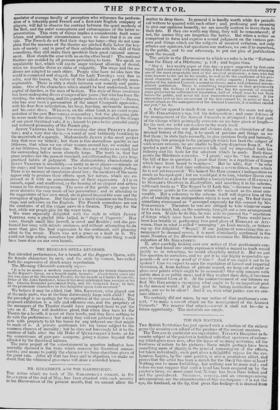THE OLD MASTERS.
THE British Institution has just opened with a selection of the richest gems the country can affbrd of the produce of the ancient masters. The TITIANS in particular are superlative. TITIAN'S Daughter (a fa- vourite subject of the painter) is touched with that openness of colour- ing which gives even now, after the lapse of so many centuries, all the freshness of nature to his pictures : there might perhaps have been something more of dignity in the general summing-up of the effects, but taken individually, cad' part gives a delightful repose for the eye. Ignatius Loyola, by the same painter, is also a prodigious effort, and proves that the artist has been a match for the Devil this time at least ! Nothing can he more forbidding, but nothing can he more real ; and before we can suppose that such a head has been conjured up by the painter's fancy, we must grant that Nature has been there before and laid the groundwork. Sternness, seventy, and an uncompromising determination, are the characteristics of this masterpiece : it is not the eye, the forehead, or the lip, that gives this feeling—it is derived from
every lineament of the countenance, and each atomy of the face bears out the same sentiment. Loyola may have provided this,—we believe it, for it hath the spirit of the man extant upon it ; but at least the artist has imbibed the expression of the soul—has supplied the gloomy, fearful tone that hangs around, and with the skill of one whose hand was capable of portraying such things, has stamped on the canvass a form that rather commands us than wins us to believe its justness.
The VANDYKES too are beyond all praise. There is the head of Sir Endymion Porter, full of the glory, without those weaknesses which are sometimes met with in VANDYKE'S pieces : there is more colour af- forded to this head than is usual with him ; and we did not like it the worse, especially as it has been managed with a carefulness and pro- priety that convey the impression that the artist was aware he was sailing a little out of his latitude, and was therefore the more deter- mined to steer closely by the compass. But VANDYKE'S greatest effort in this collection is his " Full-length Portrait of an Elderly Gen- tleman." Heavens, what a name to give to a masterpiece of VAN- DYKE !—An elderly gentleman tin-kettle !—Were the picture ours instead of Mr. PEEL'S, the portrait should certainly be of some one with a name, instead of " an elderly gentleman." But to the picture itself : it is a grand instance how age—we had almost said dotage—can be managed so as to be impressive, dignified, and imposing. The reve- rend stoops in his posture—his face marked with the crabbed finger- ing of Time—still there is a grace and a solemnity so infused through every portion of the picture, that we feel that age may have its magni- ficence as youth has its loveliness.
There are two RUYSDAELS, replete with that genuine country tranquillity: which he must have imbibed so fully to be able to ex- press it so amiably. The one which is numbered 128, is our favourite : not that the transparency of the stream, or the dashing of the fall, is more powerfully delineated than in the other, but because it is so de- lightfully combined with the wooded upland—a flourishing speck of Nature's universal green, and so happily relieved with mixture of spotless blue and summer cloud.
Joseph and Potiphar's Wife, by LEONARDO DA VINCI, is full of the grace of the painter ; but it wants somewhat more energy to hear out the story. We would have had the lady somewhat more greedy and passionfull, Joseph somewhat more decided and refusing ; as it is, the affair looks more like badinage than earnest: taking it, however, as a picture, and forgetting the story, it is one of the most happy of the whole collection—full of ease, full of grace, and full of beauty. We would willingly go through almost the entire catalogue in our observations, it is so loaded with sweets : but our limits forbid ; and we must content ourselves with bidding our readers look for Ti NTORETTO-S subjects, for RAPHAEL'S Holy Family, Mum Leo's St. John, SALVA- TOR'S Wood Scene, VELASQUEZ'S study of Heads—not to mention a score of others that are prizes for the lovers of the art. Above all, there are the portraits of several of the painters by them- selves, which for a double consideration are worth studying. A great painter, like every other'great genius, is the benefactor of mankind ; but whether it is a picture or a volume that we peruse, the author is but as an abstract being—a something without " a local habitation and a name." Not so when the painter gives us his own portrait : he has then vouchsafed to introduce us to himself, even to his very thoughts—if thoughts indeed be written in his face : he is no longer an isolated sub- ject for fancy to figure to herself, but has taken to himself a real and individual identity: it is, as it were, a volume of biography which he has put forth to the world ; and we may gaze on REMBRANDT'S head, or Guino's portraiture, in the same spirit that we resort to C.ESAR'S Commentaries, or the Life of BENVENUTO CELLINI.



















 Previous page
Previous page